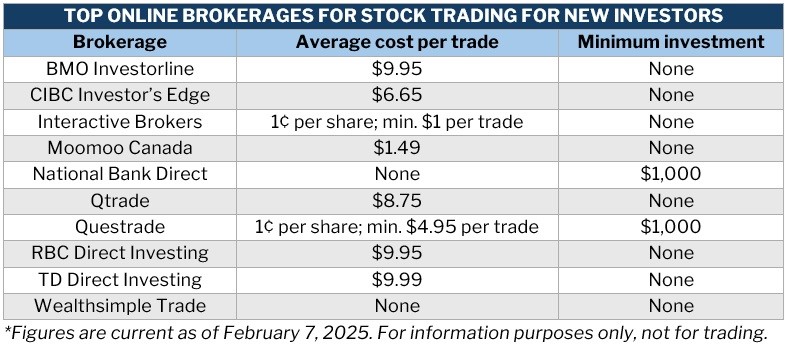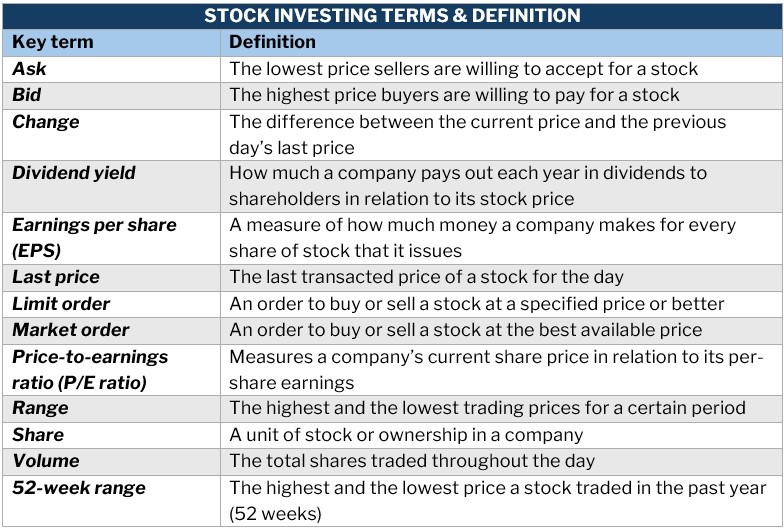Learn how to buy stocks with this step-by-step guide for new investors. Explore market insights, investing tips, and strategies for reaping higher returns

Buying stocks can be an effective way to generate passive income and build wealth, but you need to know what you’re doing. A big part of this is understanding how the stock market works. If you’re new to investing, the entire process may seem a bit overwhelming.
In this easy-to-follow guide, we’ll show you how to buy stocks if you’re just dipping your toes into investing. Along the way, we’ll offer useful tips and strategies and list the best types of stocks to buy for beginners. We’ll also explain the factors you need to consider before starting your investment journey.
If you’re a financial advisor, this article is part of our client education series and can be a good resource to share with your clients.
But first, what are stocks and how do they work?
Public companies issue stocks – also referred to as equity – as a way to fund their operations. When you buy stock, you gain partial ownership of a company. Essentially, you become a shareholder and can claim some of the firm’s profits in the form of dividends.
If you’re an investor and you think that a business has strong growth potential, you can buy stocks from this company.
If your guess is right, you can get dividends plus appreciation in the price of the shares. But if your hunch is wrong, you may see your investments shrink, or worse, go down the drain if the firm goes bankrupt.
For starters, a share is a unit of stock or ownership in a company. When you sell your shares and earn money, you get what’s known in the industry as a capital gain. If the sale causes you to lose money, it’s called capital loss.
Depending on the number of stocks you own, you may also be eligible to vote at shareholder meetings. This can be important if you want to have some form of influence in the firm’s strategic direction.
Learn more about the basics of stock trading in this guide on how to invest in stocks.
A step-by-step guide on how to buy stocks in Canada
When buying stocks, you need to follow certain steps. The process is pretty straightforward, even for new investors. Here’s a step-by-step guide on how to buy stocks for beginners:
1. Calculate how much you can invest
Most brokerages in Canada don’t require a minimum amount to buy stocks. This means that you can buy shares for as little as $10, but this restricts your options. You wouldn’t be able to buy enough to diversify, and some stock shares and mutual funds have higher minimum investments. It might also not be worth the fees and commissions.
An option is to invest in a low-cost index fund or exchange-traded fund (ETF) to diversify at a lower price. These usually don’t have minimum investments.
You can also try robo-advisors, which charge only an annual flat fee of 0.2% to 0.5% of a client’s account. One caveat: even though they make choosing stocks easier, there’s no guarantee that robo-advisors perform better than humans.
You can start to buy stocks with at least $1,000. You can work with your advisor to see how much you can invest. Make sure that you purchase shares that align with your investment goals.
2. Open an online brokerage account
Everyone who wants to buy and sell stocks needs to have a brokerage account. If you’re a self-directed investor – meaning you prefer a hands-on approach – you can open an online account and trade stocks yourself. Maintaining your account and making trades come with fees, but online brokerages are most likely your cheapest option.
If you’re not yet that confident about your stock trading skills, you can enlist the help of a stockbroker or financial advisor. You’ll get the benefit of sound expert advice, but you’ll also be paying higher fees.
Setting up an online brokerage account follows a few simple steps:
Step 1: Choose a brokerage firm
Some factors to consider when selecting a brokerage to work with include:
-
Company reputation: Go with a brokerage that’s trusted by many investors. You can also consider access to a physical location and insurance coverage, such as CIPF, for peace of mind.
-
Trading platform: The firm must have a user-friendly platform, with features and resources to help you develop your trading skills. These include trade simulators that allow you to practice buying stocks.
-
Investment options: Pick a brokerage with a wide range of investment options, including stocks, mutual funds, and ETFs. This enables you to scale up as your investment strategy evolves.
-
Fees: When it comes to fees, cheaper doesn’t necessarily mean better. Go with a brokerage that gives you the best deal for your money in terms of features and benefits.
Canadian online brokerage trading platforms vary from independent discount brokers to the bank-owned brokerage firms. Check which style works best for you.
Speaking of online brokerages, there are many in Canada to choose from. WealthSimple Trade is an excellent option for beginners. As you gain more experience and confidence in stocks, you can move to Questrade and TD Direct Investing from TD bank. Get more details on these Canadian online brokerages from this video:
Here’s a list of some of the top online brokerages in Canada to buy and sell stocks:

Step 2: Provide your personal details
Before you can open an account, you’ll need to provide some personal and financial information. These include:
- personal information: name, address, date of birth, Social Insurance Number (SIN)
- financial details: income, net worth, investment goals
- employment information for tax purposes and account verification
- bank account details for funding the account
Step 3: Complete your application
Once you’ve filled out the online application, you may need to sign some forms and answer questions about your investor profile. The process should be simple and quick. Once approved, you can fund your account and start to buy stocks.
3. Choose an investment account
You will need an investment account to hold the funds and investments. In Canada, there are several types of investment accounts to choose from. You can use either a registered or non-registered account.
Registered accounts
These are investment accounts that are given tax-deferred or tax-sheltered status by the government. Some examples include:
-
Tax-free Savings Accounts (TFSA): This allows investors aged 18 and over to invest and earn tax-free returns. You can use this account to save for your short or long-term goals, including retirement. It has an annual contribution limit, which is $7,000 for 2025.
-
Registered Retirement Savings Plans (RRSP): This lets you save for retirement and defer the taxes on earnings until you withdraw the money. RRSP account holders can contribute 18% of last year’s income, up to a maximum, which is $32,490 for 2025.
-
Registered Education Savings Plans (RESP): This allows you to save for your child’s post-secondary education. The government will also match your savings up to $7,200 to add to the fund.
Find out everything you need to know about TFSAs and RRSPs in this guide.
Non-registered accounts
You can also place stocks in non-registered accounts for personal or business purposes. These accounts don’t offer tax benefits, but they also don’t have annual contribution limits and withdrawal penalties. Here are some of your options:
-
Cash account: This lets you trade stocks with the funds in the account, just like a debit card.
-
Margin account: This allows you to borrow money from a brokerage to buy investments, including stocks. The money you borrowed must be paid with interest, much like a credit card. This type of account is more suited for experienced investors than for those who are just starting out.
4. Get acquainted with stock market terminology
A big part of learning how to buy stocks is understanding important industry terms. Here’s a list of definitions of some key stock market jargon. You can download the file for easy reference.
 Photo alt text: How to buy stocks – downloadable table with key stock market terms and definitions
Photo alt text: How to buy stocks – downloadable table with key stock market terms and definitions
5. Fund your account
Most brokerages in Canada don’t impose account minimums, but you can’t invest in stocks without funds. There’s no one-size-fits-all amount for all types of investors. It’s best to start with an amount you’re comfortable with.
6. Research potential stocks
There are different types of stocks that investors can buy to fit their investment goals and risk tolerance. Since you’re just starting out, these are your best options:
- Blue-chip stocks are from well-established companies with a strong reputation and market performance
- Green stocks feature strong ESG ratings, which measure how well a company manages its exposure to environmental, social, and governance risks
- Growth stocks are more likely to outperform industry peers with above-average revenue growth and earnings
- Income stocks pay dividends consistently and can often serve as your income stream
- International stocks are from global companies operating in foreign markets
- Penny stocks trade for less than $5 per share and often come from new, untested companies
If you want to gain valuable experience in how to buy stocks but you don’t want to risk any money, you can open a practice account. Also referred to as paper trading account or trade simulators, this simulates the stock market in real time. This way, you can learn how to buy and sell stocks without putting your hard-earned cash on the line.
7. Buy stocks
Once you feel confident enough of your stock trading skills and have done your research, it’s time to pick a stock. But where can you buy stocks? You can trade stocks from any of Canada’s exchanges listed below:
- The Canadian Securities Exchange (CSE)
- Montréal Exchange
- Nasdaq Canada
- Toronto Stock Exchange (TSX)
- TSX Venture Exchange (TSXV)
You can find the complete list of designated stock exchanges in Canada on the Department of Finance’s website.
Want to learn more about how to start trading? Check out this guide.
Factors to consider before you buy stocks
Just like with any type of investment, you will need a certain level of understanding of how stocks work before placing a trade. Given how volatile the stock market is, the stakes are high but so are the potential returns. Before you pick a stock to buy or sell, you must first consider the following:
1. Your investment goals
When deciding to buy or sell stock, it’s best to be guided by your financial goals. Ask yourself, are you in it for the long-term or do you want an investment portfolio that earns income?
Understanding your investment goals can help trim down your investment options and make the trading process easier. It will also guide you in identifying how much risk you’re willing to take and what accounts to prioritize.
2. The investment account
Once you have an idea of what type of investor you are, the next step is choosing an investment account. You’re not restricted to just one account. Some investment accounts even work well together to help you achieve your investment goals.
As a newbie investor, there are three general types of investment accounts you can use:
Brokerage account
This may suit you if you prefer a more hands-on approach to building your portfolio. Brokerage accounts let you buy and sell stocks without imposing any restrictions on the investment amount. Most brokerage firms also don’t impose rules on fund withdrawals.
Financial advisor
Getting the services of an experienced financial advisor, on the other hand, is the way to go if you want a hands-off approach to trading stocks. These industry experts will do the heavy lifting on your behalf, including making investment decisions.
Robo-advisor
This is an automated investor service made possible by machine learning and AI. It uses complex algorithms to determine your financial goals and risk profile. Based on the information it gathers, the robo-advisor makes investment decisions. This type of account may suit you if your investment goals are clear and straightforward.
3. Your risk tolerance
Risk tolerance refers to the level of risk you’re willing to take for the potential of a higher return. This plays a crucial role in how you pick stocks to buy or sell. As an investor, you can either have:
Aggressive risk tolerance
Investors with this level of risk tolerance are familiar with the markets and are accustomed to the ups and downs of their investment (stocks, in this case). Typically, investors with an aggressive risk tolerance are already wealthy, highly experienced, and have a diversified portfolio of investments and assets.
Moderate risk tolerance
Those with a moderate risk tolerance take on some level of risk, but not on the level of aggressive investors. Investors of this type balance their investment portfolios with both risky and safe assets. While they don’t gain as much as aggressive investors, they don’t lose as much either when the market falls.
Conservative risk tolerance
These are investors who take the lowest level of risk in the stock market. Their priority is to avoid losses, even at the cost of lower potential returns.
4. How much you want to invest
Part of learning how to buy stocks in Canada is determining how much of your income you want to put in your investments. The amount will depend on your investment goals and the timeframe for achieving these goals, also called time horizon.
Note that there may be restrictions on how much you can invest depending on the type of investment account you have.
Gain a deeper understanding of your investment style in this guide on how to start investing in Canada.
Do you need a broker to buy stocks in Canada?
You’re not required to hire a stockbroker to buy and sell stocks – even if you’re just starting out. But you will need to work with a brokerage firm in most cases.
Brokerages can offer you strategic investment advice and make trades on your behalf. They can even offer access to a platform where you can execute trades yourself using an automated robo-advisor. Be sure to pick a brokerage that fits your investment style.
Learning how to buy stocks in Canada can be challenging, especially for beginners, but it’s not as daunting a task as it seems. The key is equipping yourself with essential knowledge. Always seek the assistance of more experienced investors or, better yet, an expert financial advisor.
If you’re seeking guidance as you start your investment journey, our Best in Wealth Special Reports page is the place to go. The firms and professionals featured in our special reports have been handpicked by their peers and vetted by our panel of experts as trusted market leaders.
By partnering with these industry experts, you can be sure that you're making sound investment decisions and building a solid portfolio.
Did you find our guide on how to buy stocks helpful? Let us know in the comments



